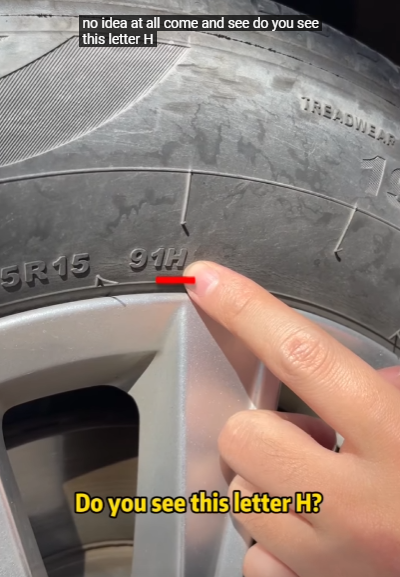
Car tires are one of the most important safety components of a vehicle, yet many drivers overlook the wealth of information hidden within them. Every tire is packed with markings and codes that provide crucial details about its size, performance, manufacturing date, and safety features. Understanding this information can help you make better purchasing decisions, improve vehicle safety, and ensure optimal driving performance. So, do you know the hidden information in car tires? Let’s uncover the secrets imprinted on those rubber wheels.

1. The Meaning Behind Tire Size Codes
One of the most noticeable pieces of information on a tire is its size code, often written as something like P215/65R16 95H. But what does this actually mean?
- P (Passenger Car Tire): The letter at the beginning indicates the tire type. “P” stands for a passenger car, while “LT” means light truck, and “ST” refers to special trailer tires.
- 215: This is the tire’s width in millimeters, measured from sidewall to sidewall.
- 65: This is the aspect ratio, which represents the height of the tire sidewall as a percentage of its width. In this case, the height is 65% of 215mm.
- R (Radial Construction): The letter “R” means the tire has radial construction, which is the most common type today.
- 16: This number represents the wheel diameter in inches, indicating the size of the rim the tire fits on.
- 95H: The final part of the code provides the load index (95) and the speed rating (H), which we’ll explain next.

2. Load Index and Speed Rating
The load index and speed rating indicate how much weight the tire can support and the maximum speed it is designed for.
- Load Index: This is a number (e.g., 95) that corresponds to a weight limit. A 95 load index means the tire can carry up to 1,521 pounds (690 kg) when properly inflated.
- Speed Rating: The letter (e.g., H) represents the maximum safe speed:
- S = 112 mph (180 km/h)
- H = 130 mph (210 km/h)
- V = 149 mph (240 km/h)
- Z = 149+ mph (240+ km/h)
Choosing the right speed rating is important, especially if you drive at high speeds on highways. Lower-rated tires may overheat and wear out faster under excessive speeds.

3. The Importance of the DOT Code
Every tire has a DOT (Department of Transportation) code imprinted on its sidewall, which tells you when and where it was manufactured.
- A typical DOT code looks like DOT B89X 0723.
- The last four digits indicate the manufacturing date: 07 23 means the tire was made in the 7th week of 2023.
- The first part of the code identifies the factory where the tire was produced.
Why is this important? Tires have a lifespan, and old tires—even with good tread—can become brittle and unsafe. Most experts recommend replacing tires after 6-10 years, regardless of tread depth.
4. Tread Wear Indicators and UTQG Rating
The UTQG (Uniform Tire Quality Grading) rating system helps consumers compare tire performance based on three factors:
- Treadwear: A number that estimates how long the tire will last. A rating of 400 means the tire should last four times longer than a reference tire rated at 100.
- Traction: Graded as AA, A, B, or C, this rating measures wet road braking performance, with AA being the best.
- Temperature Resistance: Rated as A, B, or C, this indicates how well the tire resists heat buildup.
Additionally, most tires have tread wear indicators—small rubber bars located inside the grooves. When these bars become level with the tread, it’s time to replace the tire.

5. Maximum Inflation Pressure vs. Recommended Pressure
Tires display a maximum inflation pressure, but this is NOT the pressure you should use! Instead, refer to your car’s owner’s manual or the sticker inside the driver’s door for the recommended tire pressure.
- Underinflation can lead to poor fuel economy, excessive tire wear, and potential blowouts.
- Overinflation reduces grip and makes the ride uncomfortable, increasing the risk of tire damage from potholes.
Checking your tire pressure at least once a month is essential for safety and efficiency.
6. Run-Flat and Special Markings
Some tires have additional markings indicating special features:
- RFT or ZP: These indicate run-flat tires, which allow you to drive short distances after a puncture.
- M+S (Mud and Snow): Tires with this marking provide better traction in slippery conditions.
- Three-Peak Mountain Snowflake (3PMSF): Indicates a tire meets winter performance standards and is better suited for snow and ice.
- XL (Extra Load): These tires can handle heavier loads compared to standard tires.

7. Asymmetrical vs. Directional Tread Patterns
Tires may have specific tread designs that impact performance:
- Directional Tires: Have a V-shaped tread pattern and must be installed in a specific direction for optimal water drainage and traction.
- Asymmetrical Tires: Feature different tread patterns on the inside and outside for better handling in wet and dry conditions.
- Symmetrical Tires: Can be rotated in any direction, making them more versatile and cost-effective.
Always check for rotation arrows or “inside/outside” markings to ensure proper installation.
8. The Impact of Tire Weight and Rolling Resistance
Lighter tires with low rolling resistance improve fuel efficiency. Some eco-friendly tires are designed to reduce energy loss, leading to better mileage. If you’re looking to save on fuel, consider tires labeled as LRR (Low Rolling Resistance).

Conclusion: Tires Tell a Story—Are You Listening?
Your car’s tires are more than just rubber on the road. They contain valuable information that can enhance safety, improve performance, and save you money. Understanding the hidden details in tire markings can help you choose the right set, maintain them properly, and drive with confidence.
So next time you check your tires, take a closer look—what secrets are they telling you?



